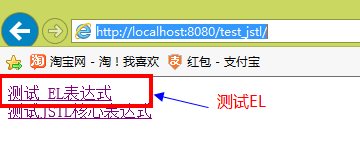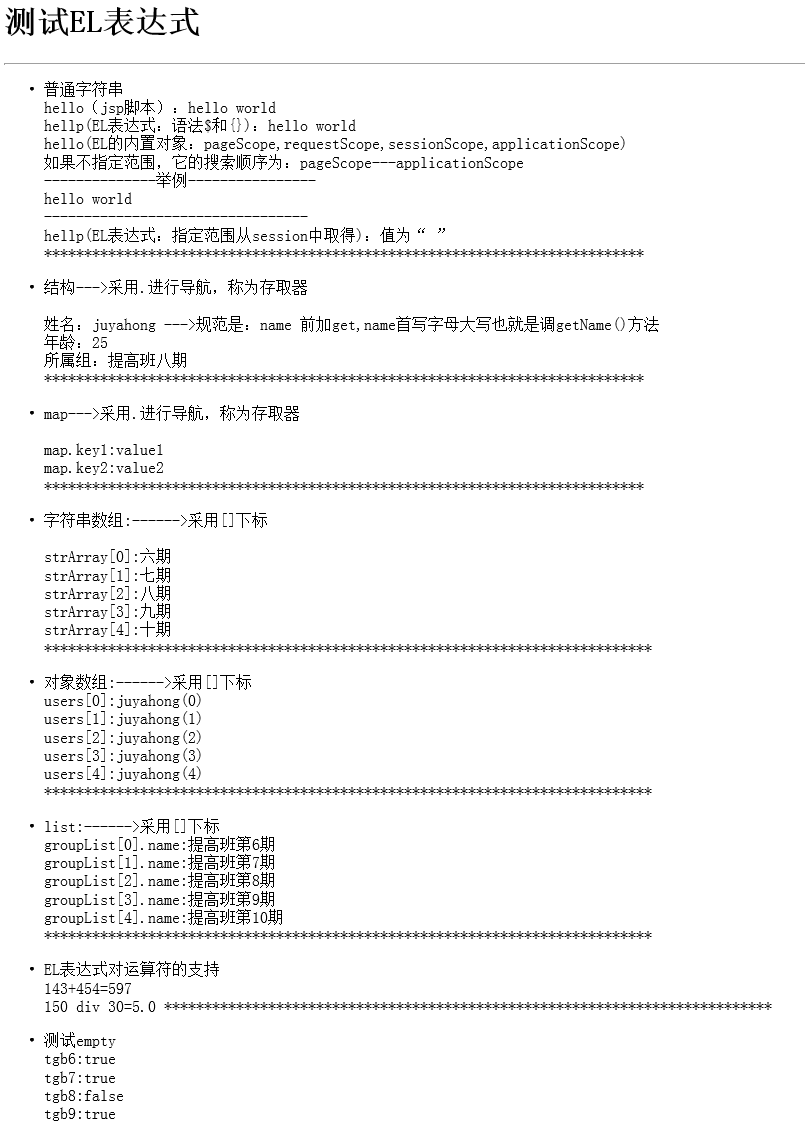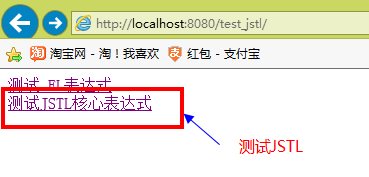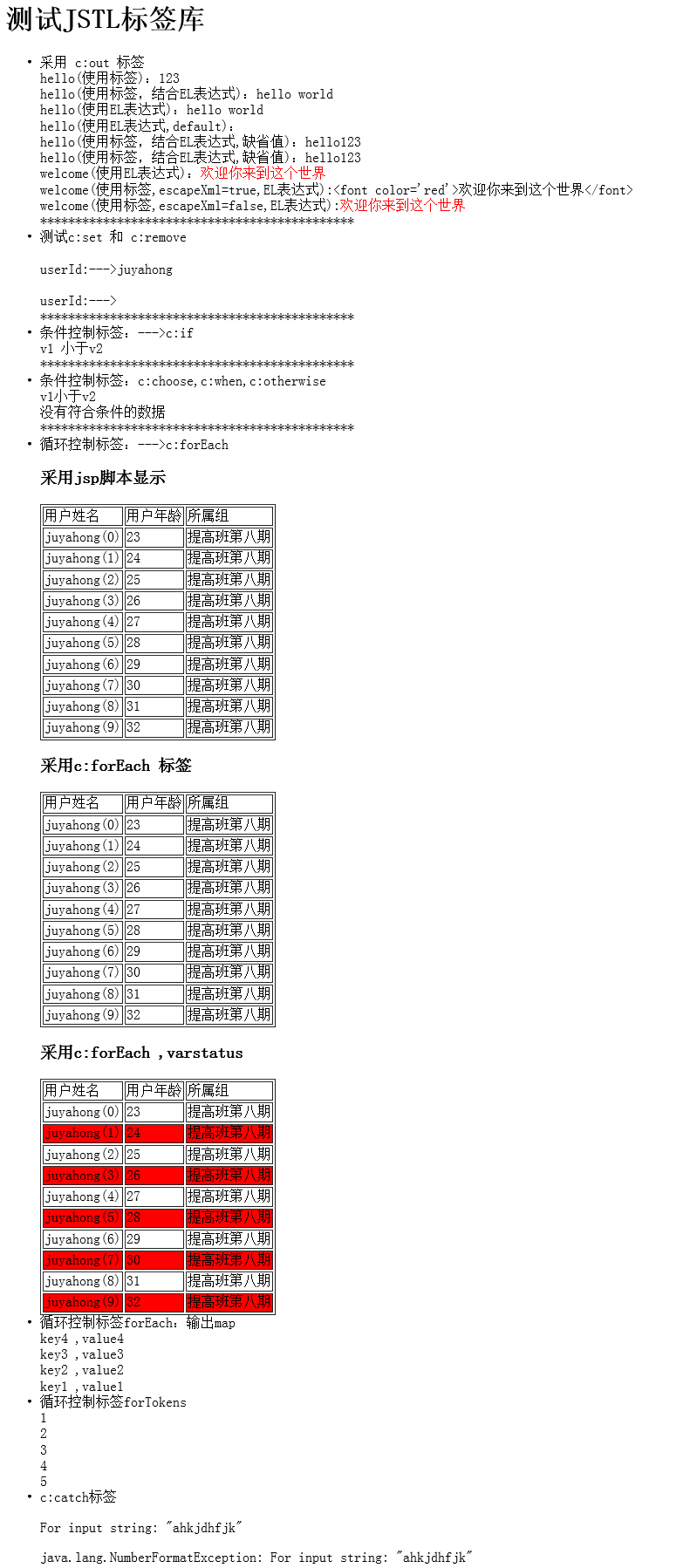所谓JSTL就是标签库 JSP Standard Tag Library,如果做为java初学者你看不懂那些$符号的话,就有必要来了解一下JSTL,如果你看到满眼的<%}%>(Scriptlet)觉得很糟心的话,那就更应该学学JSTL。
代码分离一直是程序员所追求,框架的开发者每天都费尽心思想怎么实现页面和代码分离,分离的好处比如:代码清晰,美工和程序员不干扰,各做各的等。如果满眼的<%%>就是满眼的Java代码,那就又都整合到一起了。而且将代码嵌入页面,系统编译运行时,很费时的,需要将页面中的代码转换(HTML——JAVA),返回数据时还需转换(JAVA——HTML),而且如果管理不善,很容易出事故的,所以尽量使用JSTL就能提供一种善意的限制,况且用JSTL还可以有效地提高系统速度了。特别是对于那些前台开发人员,他们可能不懂Java,只是懂一些HTML和JSTL,那么就可以做出漂亮美观的页面,也不会受java或其他语言的的困扰了,维护起来也比较简单,这样页面和代码分离了,角色分配也就更明显了,整个团队的合作也就更融洽了。就比如说我吧,刚学java,对java不是很熟悉,现在无意间被调到大系统里做界面,只要我学习了标签语言,就能很容易的将那些后台程序员的结果显示在我的页面上,所有我们就更有必要学习标签库了。
简介:
迭代和条件判断
数据管理格式化
XML操作
数据库访问
函数标签库
表达式语言EL
在学习JSTL之前要了解一下EL,它和标签库联合使用,就能避免在jsp里面出现大段的java代码段了。
EL主要用于查找作用域中的数据,然后对它们执行简单操作;它不是编程语言,甚至不是脚本编制语言。通常与 JSTL 标记一起作用,能用简单而又方便的符号来表示复杂的行为。EL的格式就是一个美元符号加一对大括号---${}。
如果只是使用EL表达式,不需要引用任何jar包。只要jsp/servlet容器实现了相关规范就可以了。
下面是EL的举例应用:
jstl_el.jsp
1 <%@ page language="java" import="java.util.*" pageEncoding="GB18030"%> 2 3 4 <% 5 String path = request.getContextPath(); 6 String basePath = request.getScheme()+"://"+request.getServerName()+":"+request.getServerPort()+path+"/"; 7 %> 8 9 <!DOCTYPE HTML PUBLIC "-//W3C//DTD HTML 4.01 Transitional//EN"> 10 <html> 11 <head> 12 <base href="<%=basePath%>"> 13 14 <title>My JSP 'jstl_el.jsp' starting page</title> 15 16 <meta http-equiv="pragma" content="no-cache"> 17 <meta http-equiv="cache-control" content="no-cache"> 18 <meta http-equiv="expires" content="0"> 19 <meta http-equiv="keywords" content="keyword1,keyword2,keyword3"> 20 <meta http-equiv="description" content="This is my page"> 21 <!-- 22 <link rel="stylesheet" type="text/css" href="styles.css"> 23 --> 24 25 </head> 26 27 <body> 28 <h1>测试EL表达式</h1> 29 <hr> 30 <ul> 31 <li>普通字符串</li> 32 hello(jsp脚本):<%=request.getAttribute("hello") %> <br> 33 hellp(EL表达式:语法$和{}):${hello }<br> 34 hello(EL的内置对象:pageScope,requestScope,sessionScope,applicationScope)<br> 35 如果不指定范围,它的搜索顺序为:pageScope---applicationScope<br> 36 --------------举例---------------- <br> 37 ${requestScope.hello } <br> 38 --------------------------------- <br> 39 hellp(EL表达式:指定范围从session中取得):值为“${sessionScope.hello } ”<br> 40 *************************************************************************** 41 <P> 42 <li>结构--->采用.进行导航,称为存取器</li><br> 43 姓名:${user.name } --->规范是:name 前加get,name首写字母大写也就是调getName()方法<br> 44 年龄:${user.age }<br> 45 所属组:${user.group.name }<br> 46 *************************************************************************** 47 <p> 48 <li>map--->采用.进行导航,称为存取器</li><br> 49 map.key1:${map.key1 } <br> 50 map.key2:${map.key2 } <br> 51 *************************************************************************** 52 <p> 53 <li>字符串数组:------>采用[]下标</li> <br> 54 strArray[0]:${str_array[0]} <br> 55 strArray[1]:${str_array[1]} <br> 56 strArray[2]:${str_array[2]} <br> 57 strArray[3]:${str_array[3]} <br> 58 strArray[4]:${str_array[4]} <br> 59 **************************************************************************** 60 <p> 61 <li>对象数组:------>采用[]下标</li> 62 users[0]:${users[0].name } <br> 63 users[1]:${users[1].name } <br> 64 users[2]:${users[2].name } <br> 65 users[3]:${users[3].name } <br> 66 users[4]:${users[4].name } <br> 67 **************************************************************************** 68 <p> 69 <li>list:------>采用[]下标</li> 70 groupList[0].name:${groupList[0].name }<br> 71 groupList[1].name:${groupList[1].name }<br> 72 groupList[2].name:${groupList[2].name }<br> 73 groupList[3].name:${groupList[3].name }<br> 74 groupList[4].name:${groupList[4].name }<br> 75 **************************************************************************** 76 <p> 77 <li>EL表达式对运算符的支持</li> 78 143+454=${143+454 }<br> 79 div 30=${150 div 30 } 80 **************************************************************************** 81 <p> 82 <li>测试empty</li> 83 tgb6:${empty tgb6 }<br> 84 tgb7:${empty tgb7 }<br> 85 tgb8:${empty tgb8 }<br> 86 tgb9:${empty tgb9 }<br> 87 88 89 </ul> 90 </body> 91 </html>
JstlElServlet.java
1 package com.tgb.jstl; 2 3 import java.io.IOException; 4 import java.io.PrintWriter; 5 import java.util.ArrayList; 6 import java.util.HashMap; 7 import java.util.List; 8 import java.util.Map; 9 10 import javax.servlet.ServletException; 11 import javax.servlet.http.HttpServlet; 12 import javax.servlet.http.HttpServletRequest; 13 import javax.servlet.http.HttpServletResponse; 14 15 import com.sun.org.apache.bcel.internal.generic.NEW; 16 17 /** 18 * 测试EL表达式 22 */ 23 public class JstlElServlet extends HttpServlet { 24 25 /** 26 * Constructor of the object. 27 */ 28 public JstlElServlet() { 29 super(); 30 } 31 32 /** 33 * Destruction of the servlet. <br> 34 */ 35 public void destroy() { 36 super.destroy(); // Just puts "destroy" string in log 37 // Put your code here 38 } 39 40 /** 41 * The doGet method of the servlet. <br> 42 * 43 * This method is called when a form has its tag value method equals to get. 44 * 45 * @param request the request send by the client to the server 46 * @param response the response send by the server to the client 47 * @throws ServletException if an error occurred 48 * @throws IOException if an error occurred 49 */ 50 public void doGet(HttpServletRequest request, HttpServletResponse response) 51 throws ServletException, IOException { 52 //普通字符串 53 request.setAttribute("hello", "hello world"); 54 55 //结构 56 Group group=new Group(); 57 group.setName("提高班八期"); 58 59 User user=new User(); 60 user.setName("juyahong"); 61 user.setAge(25); 62 user.setGroup(group); 63 request.setAttribute("user", user); 64 65 66 //map 67 Map map=new HashMap(); 68 map.put("key1", "value1"); 69 map.put("key2", "value2"); 70 request.setAttribute("map", map); 71 72 //字符串数组 73 String[] strArray=new String[]{"六期","七期","八期","九期","十期"}; 74 request.setAttribute("str_array", strArray); 75 76 77 //对象数组 78 User[] users=new User[5]; 79 for (int i = 0; i < users.length; i++) { 80 users[i]=new User(); 81 users[i].setName("juyahong("+i+")"); 82 } 83 request.setAttribute("users", users); 84 85 86 //list 87 List groupList=new ArrayList(); 88 for (int i = 6; i < 12; i++) { 89 Group group2=new Group(); 90 group2.setName("提高班第"+i+"期"); 91 groupList.add(group2); 92 } 93 request.setAttribute("groupList", groupList); 94 95 96 //empty 97 request.setAttribute("tgb6", ""); 98 request.setAttribute("tgb7", new ArrayList()); 99 request.setAttribute("tgb8", "提高班第八期"); 100 request.setAttribute("tgb9", null); 101 //request的分发器 102 request.getRequestDispatcher("/jstl_el.jsp").forward(request, response); 103 104 } 105 106 /** 107 * The doPost method of the servlet. <br> 108 * 109 * This method is called when a form has its tag value method equals to post. 110 * 111 * @param request the request send by the client to the server 112 * @param response the response send by the server to the client 113 * @throws ServletException if an error occurred 114 * @throws IOException if an error occurred 115 */ 116 public void doPost(HttpServletRequest request, HttpServletResponse response) 117 throws ServletException, IOException { 118 119 response.setContentType("text/html"); 120 PrintWriter out = response.getWriter(); 121 out.println("<!DOCTYPE HTML PUBLIC "-//W3C//DTD HTML 4.01 Transitional//EN">"); 122 out.println("<HTML>"); 123 out.println(" <HEAD><TITLE>A Servlet</TITLE></HEAD>"); 124 out.println(" <BODY>"); 125 out.print(" This is "); 126 out.print(this.getClass()); 127 out.println(", using the POST method"); 128 out.println(" </BODY>"); 129 out.println("</HTML>"); 130 out.flush(); 131 out.close(); 132 } 133 134 /** 135 * Initialization of the servlet. <br> 136 * 137 * @throws ServletException if an error occurs 138 */ 139 public void init() throws ServletException { 140 // Put your code here 141 } 142 143 }
Group.java
1 package com.tgb.jstl; 2 3 public class Group { 4 private String name; 5 6 public String getName() { 7 return name; 8 } 9 10 public void setName(String name) { 11 this.name = name; 12 } 13 14 }
User.java
1 package com.tgb.jstl; 2 3 public class User { 4 private String name; 5 private int age; 6 private Group group; 7 public String getName() { 8 return name; 9 } 10 public void setName(String name) { 11 this.name = name; 12 } 13 public int getAge() { 14 return age; 15 } 16 public void setAge(int age) { 17 this.age = age; 18 } 19 public Group getGroup() { 20 return group; 21 } 22 public void setGroup(Group group) { 23 this.group = group; 24 } 25 26 }
web.xml 建立映射
1 <servlet> 2 <servlet-name>JstlElServlet</servlet-name> 3 <servlet-class>com.tgb.jstl.JstlElServlet</servlet-class> 4 </servlet> 5 <!-- 映射到servlet --> 6 <servlet-mapping> 7 <servlet-name>JstlElServlet</servlet-name> 8 <url-pattern>/servlet/JstlElServlet</url-pattern> 9 </servlet-mapping>
效果:


EL表达式非常简单,只是一个${}就解决了,但是它的功能却非常单一,只能取得特定的某一个元素。如果想要遍历就不行了,再加上一些条件分支判断什么的也不行,也无法做到日期、数字等的格式化。所以要结合相应的标签来达到这样的效果。
那么我们就需要一个标签库即JSTL。但是需要引入它的库,将jstl.jar和standard.jar考到WEB-INF/lib下,然后采用tablib指令引入标签库。
<%@ taglib uri="http://java.sun.com/jsp/jstl/core" prefix ="c" %>
下面代码举例应用:
jstl_core.jsp
1 <%@page import="javax.servlet.jsp.tagext.TryCatchFinally"%> 2 <%@page import="com.tgb.jstl.User"%> 3 <%@ page language="java" import="java.util.*" pageEncoding="GB18030"%> 4 <%@ taglib uri="http://java.sun.com/jsp/jstl/core" prefix="c" %> 5 6 <% 7 String path = request.getContextPath(); 8 String basePath = request.getScheme()+"://"+request.getServerName()+":"+request.getServerPort()+path+"/"; 9 %> 10 11 <!DOCTYPE HTML PUBLIC "-//W3C//DTD HTML 4.01 Transitional//EN"> 12 <html> 13 <head> 14 <base href="<%=basePath%>"> 15 16 <title>My JSP 'jstl_core.jsp' starting page</title> 17 18 <meta http-equiv="pragma" content="no-cache"> 19 <meta http-equiv="cache-control" content="no-cache"> 20 <meta http-equiv="expires" content="0"> 21 <meta http-equiv="keywords" content="keyword1,keyword2,keyword3"> 22 <meta http-equiv="description" content="This is my page"> 23 <!-- 24 <link rel="stylesheet" type="text/css" href="styles.css"> 25 --> 26 27 </head> 28 29 <body> 30 <h1>测试JSTL标签库</h1> 31 <ul> 32 <li>采用 c:out 标签</li> 33 hello(使用标签):<c:out value="123"></c:out> <br> 34 hello(使用标签,结合EL表达式):<c:out value="${hello }"></c:out><br> 35 hello(使用EL表达式):${hello }<br> 36 hello(使用EL表达式,default):${hello123 }<br> 37 hello(使用标签,结合EL表达式,缺省值):<c:out value="${hello123 }" default="hello123"></c:out><br> 38 hello(使用标签,结合EL表达式,缺省值):<c:out value="${hello123 }" >hello123</c:out><br> 39 welcome(使用EL表达式):${welcome } <br> 40 welcome(使用标签,escapeXml=true,EL表达式):<c:out value="${welcome }" escapeXml="true"></c:out> <br> 41 welcome(使用标签,escapeXml=false,EL表达式):<c:out value="${welcome }" escapeXml="false"></c:out> <br> 42 ********************************************* 43 <li>测试c:set 和 c:remove</li> 44 <c:set value="juyahong" var="userId"></c:set><br> 45 userId:--->${userId } <br> 46 <c:remove var="userId"/> <br> 47 userId:--->${userId } <br> 48 ********************************************* 49 <li>条件控制标签:--->c:if</li> 50 <c:if test="${v1 lt v2 }"> 51 v1 小于v2 <br> 52 </c:if> 53 54 ********************************************* 55 <li>条件控制标签:c:choose,c:when,c:otherwise</li> 56 <c:choose> 57 <c:when test="${v1 gt v2 }"> 58 v1大于v2<br> 59 </c:when> 60 <c:otherwise> 61 v1小于v2<br> 62 </c:otherwise> 63 </c:choose> 64 65 <c:choose> 66 67 <c:when test="${empty userList }"> 68 没有符合条件的数据<br> 69 </c:when> 70 <c:otherwise> 71 存在用户数据<br> 72 </c:otherwise> 73 </c:choose> 74 ********************************************* 75 <li>循环控制标签:--->c:forEach</li> 76 <h3>采用jsp脚本显示</h3> 77 78 <table border="1px"> 79 <tr> 80 <td>用户姓名</td> 81 <td>用户年龄</td> 82 <td>所属组</td> 83 </tr> 84 <% 85 List userList=(List)request.getAttribute("users"); 86 if(userList == null || userList.size()==0){ 87 %> 88 <tr> 89 <td colspan="3">没有符合条件的数据</td> 90 </tr> 91 <% 92 }else { 93 for(Iterator iter=userList.iterator();iter.hasNext();){ 94 User user=(User)iter.next(); 95 %> 96 <tr> 97 <td><%=user.getName() %></td> 98 <td><%=user.getAge() %></td> 99 <td><%=user.getGroup().getName() %></td> 100 </tr> 101 102 <% 103 } 104 } 105 %> 106 </table> 107 <h3>采用c:forEach 标签</h3> 108 <table border="1px"> 109 <tr> 110 <td>用户姓名</td> 111 <td>用户年龄</td> 112 <td>所属组</td> 113 </tr> 114 <c:choose> 115 <c:when test="${empty users }"> 116 <tr> 117 <td colspan="3">没有符合条件的数据</td> 118 </tr> 119 </c:when> 120 <c:otherwise> 121 <c:forEach items="${users }" var="user"> 122 <tr> 123 <td>${user.name }</td> 124 <td>${user.age }</td> 125 <td>${user.group.name }</td> 126 </tr> 127 </c:forEach> 128 </c:otherwise> 129 </c:choose> 130 </table> 131 <h3>采用c:forEach ,varstatus</h3> 132 <table border="1px"> 133 <tr> 134 <td>用户姓名</td> 135 <td>用户年龄</td> 136 <td>所属组</td> 137 </tr> 138 <c:choose> 139 <c:when test="${empty users }"> 140 <tr> 141 <td colspan="3">没有符合条件的数据</td> 142 </tr> 143 </c:when> 144 <c:otherwise> 145 <c:forEach items="${users }" var="user" varStatus="vs"> 146 <c:choose> 147 <c:when test="${vs.count mod 2==0 }"> 148 <tr bgcolor="red"> 149 </c:when> 150 <c:otherwise> 151 <tr> 152 </c:otherwise> 153 </c:choose> 154 <td>${user.name }</td> 155 <td>${user.age }</td> 156 <td>${user.group.name }</td> 157 </tr> 158 </c:forEach> 159 160 </c:otherwise> 161 </c:choose> 162 </table> 163 <li>循环控制标签forEach:输出map</li> 164 <c:forEach items="${map }" var="entry"> 165 ${entry.key } ,${entry.value } <br> 166 </c:forEach> 167 <li>循环控制标签forTokens</li> 168 <c:forTokens items="${strTokens} " delims="#" var="v"> 169 ${v } <br> 170 </c:forTokens> 171 <li>c:catch标签</li> 172 <p> 173 <% 174 try{ 175 Integer.parseInt("ahkjdhfjk"); 176 } catch(Exception e){ 177 out.println(e.getMessage()); 178 } 179 %> 180 </p> 181 <P> 182 <c:catch var="msg"> 183 <% 184 Integer.parseInt("ahkjdhfjk"); 185 %> 186 </c:catch> 187 ${msg } 188 </P> 189 190 </ul> 191 </body> 192 </html>
JstlCoreServlet.java
1 package com.tgb.jstl; 2 3 import java.io.IOException; 4 import java.io.PrintWriter; 5 import java.util.ArrayList; 6 import java.util.HashMap; 7 import java.util.List; 8 import java.util.Map; 9 10 import javax.servlet.ServletException; 11 import javax.servlet.http.HttpServlet; 12 import javax.servlet.http.HttpServletRequest; 13 import javax.servlet.http.HttpServletResponse; 14 15 16 /** 17 * 演示JSTL核心库21 */ 22 public class JstlCoreServlet extends HttpServlet { 23 24 /** 25 * @author 巨亚红 26 * @date 2014-1-8 下午5:36:05 27 * @版本 V1.0 作者: 时间: 修改: 28 */ 29 private static final long serialVersionUID = 1L; 30 /** 31 * Constructor of the object. 32 */ 33 public JstlCoreServlet() { 34 super(); 35 } 36 37 38 39 /** 40 * The doGet method of the servlet. <br> 41 * 42 * This method is called when a form has its tag value method equals to get. 43 * 44 * @param request the request send by the client to the server 45 * @param response the response send by the server to the client 46 * @throws ServletException if an error occurred 47 * @throws IOException if an error occurred 48 */ 49 public void doGet(HttpServletRequest request, HttpServletResponse response) 50 throws ServletException, IOException { 51 52 // 普通字符串 53 request.setAttribute("hello", "hello world"); 54 55 //HTML字符串 56 request.setAttribute("welcome", "<font color='red'>欢迎你来到这个世界</font>"); 57 58 //条件控制标签 59 request.setAttribute("v1", 10); 60 request.setAttribute("v2", 20); 61 62 request.setAttribute("userList", new ArrayList()); 63 64 //结构 65 66 67 Group group = new Group(); 68 group.setName("提高班第八期"); 69 70 List users = new ArrayList(); 71 for (int i=0; i<10; i++) { 72 User user = new User(); 73 user.setName("juyahong(" + i+")"); 74 user.setAge(23 + i); 75 user.setGroup(group); 76 users.add(user); 77 } 78 request.setAttribute("users", users); 79 80 81 //map 82 Map map=new HashMap(); 83 map.put("key1", "value1"); 84 map.put("key2", "value2"); 85 map.put("key3", "value3"); 86 map.put("key4", "value4"); 87 request.setAttribute("map", map); 88 89 90 //forTokens 91 request.setAttribute("strTokens", "1#2#3#4#5"); 92 93 request.getRequestDispatcher("/jstl_core.jsp").forward(request, response); 94 95 } 96 }
web.xml
1 <servlet> 2 <servlet-name>JstlCoreServlet</servlet-name> 3 <servlet-class>com.tgb.jstl.JstlCoreServlet</servlet-class> 4 </servlet> 5 <servlet-mapping> 6 <servlet-name>JstlCoreServlet</servlet-name> 7 <url-pattern>/servlet/JstlCoreServlet</url-pattern> 8 </servlet-mapping>
效果图:


通过上面的例子,JSTL也学习到了大部分了,希望以后的项目中多多运用,多多学习。
注:转自http://www.cnblogs.com/jyh317/p/3514836.html